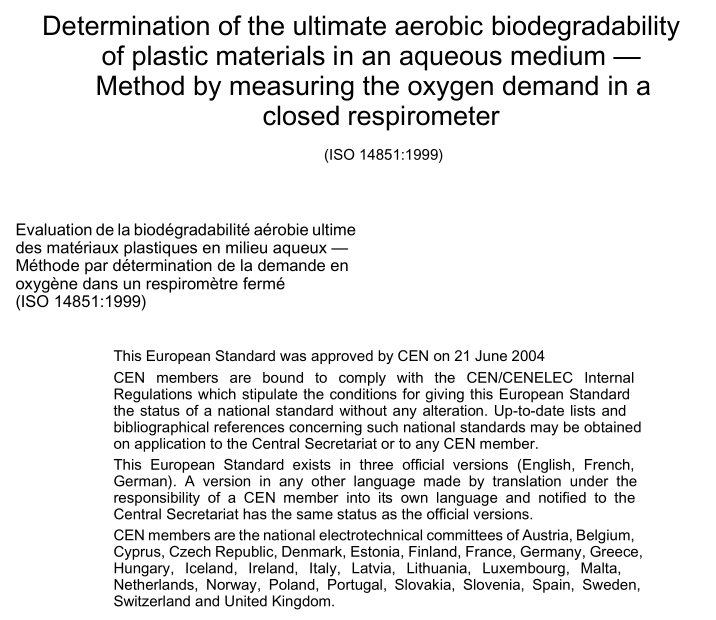BS EN ISO 14851 pdf download

BS EN ISO 14851 pdf download Determination of the ultimate aerobic biodegradability of plastic materials in an aqueous medium — Method by measuring the oxygen demand in a closed respirometer
7 Apparatus Ensure that all glassware is thoroughly cleaned and, in particular, free from organic or toxic matter. Required is usual laboratory equipment, plus the following:
7.1 Closed respirometer, including test vessels (glass flasks) fitted with stirrers and all other necessary equipment, and located in a constant-temperature room or in a thermostatted apparatus (e.g. water-bath). For an example, see Annex C. NOTE Any respirometer able to determine with sufficient accuracy the biochemical oxygen demand is suitable, preferably an apparatus which measures and replaces automatically and continuously the oxygen consumed so that no oxygen deficiency and no inhibition of the microbial activity occurs during the degradation process. Instead of an ordinary respirometer, the two-phase closed-bottle version may be used (see Annex D).
7.2 Analytical equipment for measuring total organic carbon (TOC) and dissolved organic carbon (DOC) (see ISO 8245).
7.3 Analytical equipment for measuring nitrate and nitrite concentrations NOTE A qualitative test is recommended first to decide if any nitrification has occurred. If there is evidence of nitrate/nitrite in the medium, a quantitative determination using a suitable method (for example ion chromatography) is required.
7.4 Centrifuge, or filtration device with membrane filters (0,45 4m pore size) which neither adsorb nor release organic carbon significantly.
7.5 Analytical balance (usual laboratory equipment).
7.6 pH meter (usual laboratory equipment). 8 Procedure 8.1 Test material The test material shall be of known mass and contain sufficient carbon to yield a BOD that can be adequately measured by the respirometer used. Calculate from the chemical formula or determine by elemental analysis the ThOD (see Annex A) and the TOC (using e.g. ISO 8245). Use a test-material concentration of at least 100 mg/l, corresponding to a ThOD of about 170 mg/l or a TOC of about 60 mg/l. Use lower concentrations only if the sensitivity of the respirometer is adequate. The maximum amount of test material is limited by the oxygen supply to the respirometer and the test medium used. When using the optimized test medium (6.2.2), the test-material concentration shall be such that the TOC does not exceed about 2 000 mg/l, i.e. a C:N ratio of about 40:1.
If higher concentrations are to be tested, increase the amount of nitrogen in the test medium.
NOTE 1 If biodegradation processes in natural environments are to be simulated, the use of the standard medium and a test-material concentration of 100 mg/l are recommended.
NOTE 2 The test material should preferably be used in powder form, but it may also be introduced as films, pieces, fragments or shaped articles. The form and shape of the test material may influence its biodegradability. Similar shapes should preferably be used if different kinds of plastic material are to be compared. If the test material is used in the form of a powder, particles of known, narrow size distribution should be used. A particle-size distribution with the maximum at 250 4m diameter is recommended. Also, the size of the test equipment used may depend on the form of the test material. It should be ascertained that no substantial mechanical aberrations occur due to the test conditions, for example due to the type of stirring mechanism used. Processing of the test material (e.g. the use of powder in the case of composites) should not influence significantly the degradation behaviour of the material. Optionally, record the hydrogen, oxygen, nitrogen, phosphorus and sulfur contents and the molecular mass of a polymeric test material, using for example liquid exclusion chromatography (see e.g. ASTM D 3536-91[1] or any other applicable standard method). Preferably, plastic materials without additives such as plasticizers should be tested. When the material does contain such additives, information on their biodegradability will be needed to assess the biodegradability of the polymeric material itself. For details on how to handle poorly water-soluble compounds, see ISO 10634.
8.2 Reference material Use aniline and/or a well defined biodegradable polymer (for example microcrystalline cellulose powder, ashless cellulose filters or poly-¶-hydroxybutyrate) as a reference material. If possible, the TOC, form and size should be comparable to that of the test material. As a negative control, a non-biodegradable polymer (e.g. polyethylene) in the same form as the test material can optionally be used.









